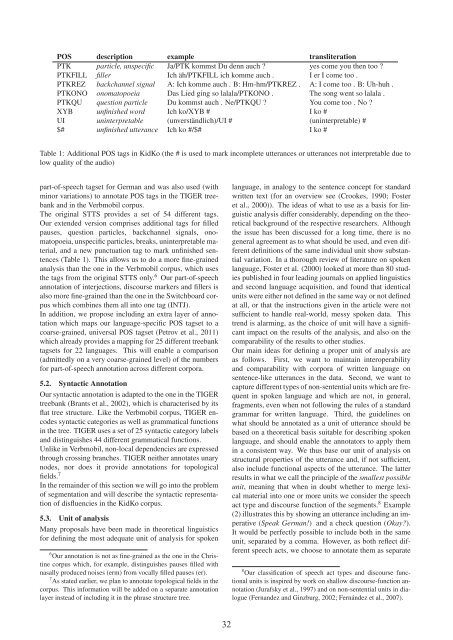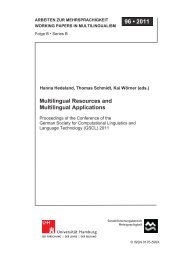Best Practices for Speech Corpora in Linguistic Research Workshop ...
Best Practices for Speech Corpora in Linguistic Research Workshop ...
Best Practices for Speech Corpora in Linguistic Research Workshop ...
Create successful ePaper yourself
Turn your PDF publications into a flip-book with our unique Google optimized e-Paper software.
POS description example transliteration<br />
PTK particle, unspecific Ja/PTK kommst Du denn auch ? yes come you then too ?<br />
PTKFILL filler Ich äh/PTKFILL ich komme auch . I er I come too .<br />
PTKREZ backchannel signal A: Ich komme auch . B: Hm-hm/PTKREZ . A: I come too . B: Uh-huh .<br />
PTKONO onomatopoeia Das Lied g<strong>in</strong>g so lalala/PTKONO . The song went so lalala .<br />
PTKQU question particle Du kommst auch . Ne/PTKQU ? You come too . No ?<br />
XYB unf<strong>in</strong>ished word Ich ko/XYB # I ko #<br />
UI un<strong>in</strong>terpretable (unverständlich)/UI # (un<strong>in</strong>terpretable) #<br />
$# unf<strong>in</strong>ished utterance Ich ko #/$# I ko #<br />
Table 1: Additional POS tags <strong>in</strong> KidKo (the # is used to mark <strong>in</strong>complete utterances or utterances not <strong>in</strong>terpretable due to<br />
low quality of the audio)<br />
part-of-speech tagset <strong>for</strong> German and was also used (with<br />
m<strong>in</strong>or variations) to annotate POS tags <strong>in</strong> the TIGER treebank<br />
and <strong>in</strong> the Verbmobil corpus.<br />
The orig<strong>in</strong>al STTS provides a set of 54 different tags.<br />
Our extended version comprises additional tags <strong>for</strong> filled<br />
pauses, question particles, backchannel signals, onomatopoeia,<br />
unspecific particles, breaks, un<strong>in</strong>terpretable material,<br />
and a new punctuation tag to mark unf<strong>in</strong>ished sentences<br />
(Table 1). This allows us to do a more f<strong>in</strong>e-gra<strong>in</strong>ed<br />
analysis than the one <strong>in</strong> the Verbmobil corpus, which uses<br />
the tags from the orig<strong>in</strong>al STTS only. 6 Our part-of-speech<br />
annotation of <strong>in</strong>terjections, discourse markers and fillers is<br />
also more f<strong>in</strong>e-gra<strong>in</strong>ed than the one <strong>in</strong> the Switchboard corpus<br />
which comb<strong>in</strong>es them all <strong>in</strong>to one tag (INTJ).<br />
In addition, we propose <strong>in</strong>clud<strong>in</strong>g an extra layer of annotation<br />
which maps our language-specific POS tagset to a<br />
coarse-gra<strong>in</strong>ed, universal POS tagset (Petrov et al., 2011)<br />
which already provides a mapp<strong>in</strong>g <strong>for</strong> 25 different treebank<br />
tagsets <strong>for</strong> 22 languages. This will enable a comparison<br />
(admittedly on a very coarse-gra<strong>in</strong>ed level) of the numbers<br />
<strong>for</strong> part-of-speech annotation across different corpora.<br />
5.2. Syntactic Annotation<br />
Our syntactic annotation is adapted to the one <strong>in</strong> the TIGER<br />
treebank (Brants et al., 2002), which is characterised by its<br />
flat tree structure. Like the Verbmobil corpus, TIGER encodes<br />
syntactic categories as well as grammatical functions<br />
<strong>in</strong> the tree. TIGER uses a set of 25 syntactic category labels<br />
and dist<strong>in</strong>guishes 44 different grammatical functions.<br />
Unlike <strong>in</strong> Verbmobil, non-local dependencies are expressed<br />
through cross<strong>in</strong>g branches. TIGER neither annotates unary<br />
nodes, nor does it provide annotations <strong>for</strong> topological<br />
fields. 7<br />
In the rema<strong>in</strong>der of this section we will go <strong>in</strong>to the problem<br />
of segmentation and will describe the syntactic representation<br />
of disfluencies <strong>in</strong> the KidKo corpus.<br />
5.3. Unit of analysis<br />
Many proposals have been made <strong>in</strong> theoretical l<strong>in</strong>guistics<br />
<strong>for</strong> def<strong>in</strong><strong>in</strong>g the most adequate unit of analysis <strong>for</strong> spoken<br />
6 Our annotation is not as f<strong>in</strong>e-gra<strong>in</strong>ed as the one <strong>in</strong> the Christ<strong>in</strong>e<br />
corpus which, <strong>for</strong> example, dist<strong>in</strong>guishes pauses filled with<br />
nasally produced noises (erm) from vocally filled pauses (er).<br />
7 As stated earlier, we plan to annotate topological fields <strong>in</strong> the<br />
corpus. This <strong>in</strong><strong>for</strong>mation will be added on a separate annotation<br />
layer <strong>in</strong>stead of <strong>in</strong>clud<strong>in</strong>g it <strong>in</strong> the phrase structure tree.<br />
32<br />
language, <strong>in</strong> analogy to the sentence concept <strong>for</strong> standard<br />
written text (<strong>for</strong> an overview see (Crookes, 1990; Foster<br />
et al., 2000)). The ideas of what to use as a basis <strong>for</strong> l<strong>in</strong>guistic<br />
analysis differ considerably, depend<strong>in</strong>g on the theoretical<br />
background of the respective researchers. Although<br />
the issue has been discussed <strong>for</strong> a long time, there is no<br />
general agreement as to what should be used, and even different<br />
def<strong>in</strong>itions of the same <strong>in</strong>dividual unit show substantial<br />
variation. In a thorough review of literature on spoken<br />
language, Foster et al. (2000) looked at more than 80 studies<br />
published <strong>in</strong> four lead<strong>in</strong>g journals on applied l<strong>in</strong>guistics<br />
and second language acquisition, and found that identical<br />
units were either not def<strong>in</strong>ed <strong>in</strong> the same way or not def<strong>in</strong>ed<br />
at all, or that the <strong>in</strong>structions given <strong>in</strong> the article were not<br />
sufficient to handle real-world, messy spoken data. This<br />
trend is alarm<strong>in</strong>g, as the choice of unit will have a significant<br />
impact on the results of the analysis, and also on the<br />
comparability of the results to other studies.<br />
Our ma<strong>in</strong> ideas <strong>for</strong> def<strong>in</strong><strong>in</strong>g a proper unit of analysis are<br />
as follows. First, we want to ma<strong>in</strong>ta<strong>in</strong> <strong>in</strong>teroperability<br />
and comparability with corpora of written language on<br />
sentence-like utterances <strong>in</strong> the data. Second, we want to<br />
capture different types of non-sentential units which are frequent<br />
<strong>in</strong> spoken language and which are not, <strong>in</strong> general,<br />
fragments, even when not follow<strong>in</strong>g the rules of a standard<br />
grammar <strong>for</strong> written language. Third, the guidel<strong>in</strong>es on<br />
what should be annotated as a unit of utterance should be<br />
based on a theoretical basis suitable <strong>for</strong> describ<strong>in</strong>g spoken<br />
language, and should enable the annotators to apply them<br />
<strong>in</strong> a consistent way. We thus base our unit of analysis on<br />
structural properties of the utterance and, if not sufficient,<br />
also <strong>in</strong>clude functional aspects of the utterance. The latter<br />
results <strong>in</strong> what we call the pr<strong>in</strong>ciple of the smallest possible<br />
unit, mean<strong>in</strong>g that when <strong>in</strong> doubt whether to merge lexical<br />
material <strong>in</strong>to one or more units we consider the speech<br />
act type and discourse function of the segments. 8 Example<br />
(2) illustrates this by show<strong>in</strong>g an utterance <strong>in</strong>clud<strong>in</strong>g an imperative<br />
(Speak German!) and a check question (Okay?).<br />
It would be perfectly possible to <strong>in</strong>clude both <strong>in</strong> the same<br />
unit, separated by a comma. However, as both reflect different<br />
speech acts, we choose to annotate them as separate<br />
8 Our classification of speech act types and discourse functional<br />
units is <strong>in</strong>spired by work on shallow discourse-function annotation<br />
(Jurafsky et al., 1997) and on non-sentential units <strong>in</strong> dialogue<br />
(Fernandez and G<strong>in</strong>zburg, 2002; Fernández et al., 2007).



